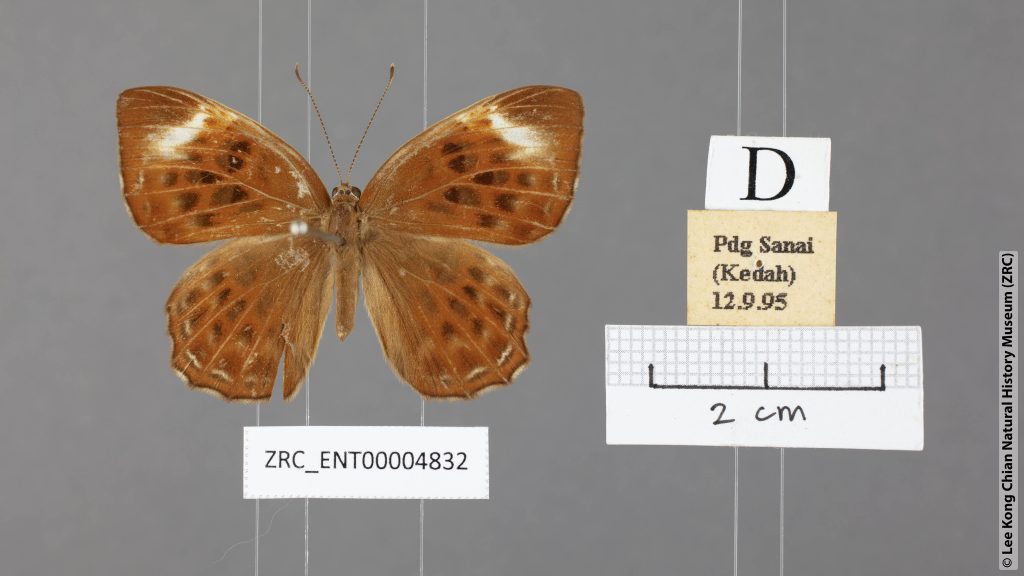Digital Collection of Butterflies of Singapore & Peninsular Malaysia
In conjunction with the Singapore HeritageFest 2022
Online Exhibition
In 2019, the museum embarked on a butterfly digitisation project with an aim to create a virtual collection of butterflies from Singapore and Peninsular Malaysia. We digitised 12,702 specimens, comprising 978 species and 1,112 subspecies from six families. These specimens were collected across 187 known localities in Singapore and Peninsular Malaysia over 63 years (1936–1998). Among the butterflies digitised, 319 species are considered to be rare or very rare. This digital exhibition presents highlights from the digitised collection which will amaze and enthrall you.
To learn more about the project and see all 12,702 specimens, click here.
Click on the images below to have a closer look.
HESPERIIDAE
Satarupa golapa malaya (Hesperiidae)

Satarupa golapa malaya is found in the hilly areas of Malaysia, including Cameron Highlands, Genting Highlands and Fraser’s hill. It has been recorded from southern Myanmar and Sumatra, and considered to be a very rare subspecies when first described by its author Brigadier William Harry Evans in 1932.
NYMPHALIDAE
Agatasa calydonia (Nymphalidae, Charaxinae)
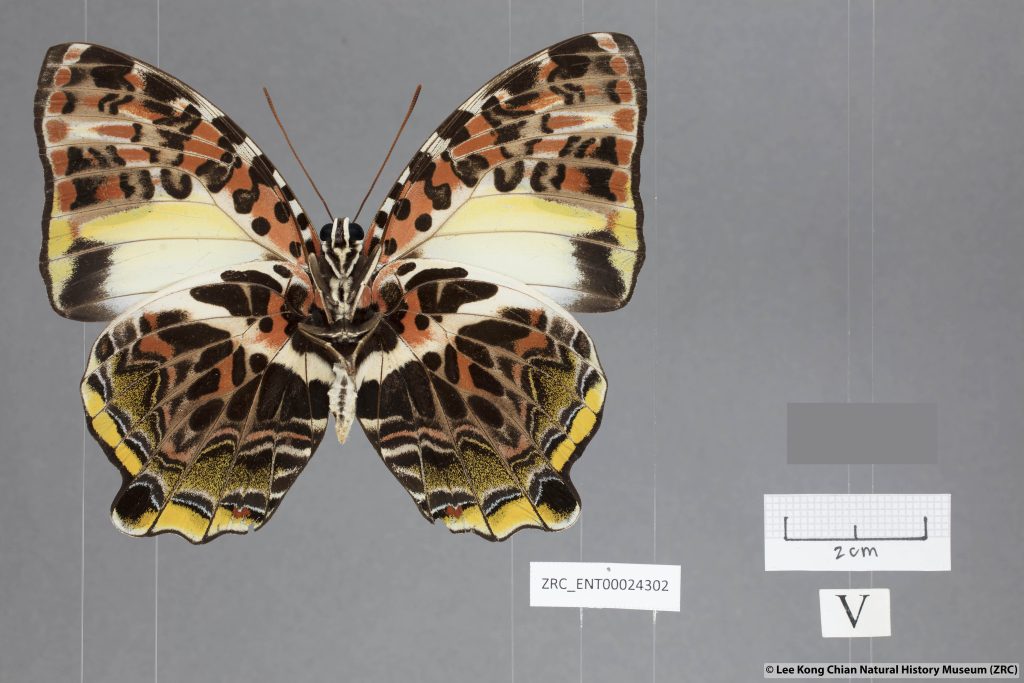
Agatasa calydonia was first described by William Chapman Hewitson in 1855, based on a specimen collected by Alfred Russell Wallace in Malacca, Malaysia. Hewitson remarked in his original description, “This glorious butterfly is beyond description”. [Dorsal view (top); Ventral view (bottom)]
Charaxes solon echo (Nymphalidae, Charaxinae)
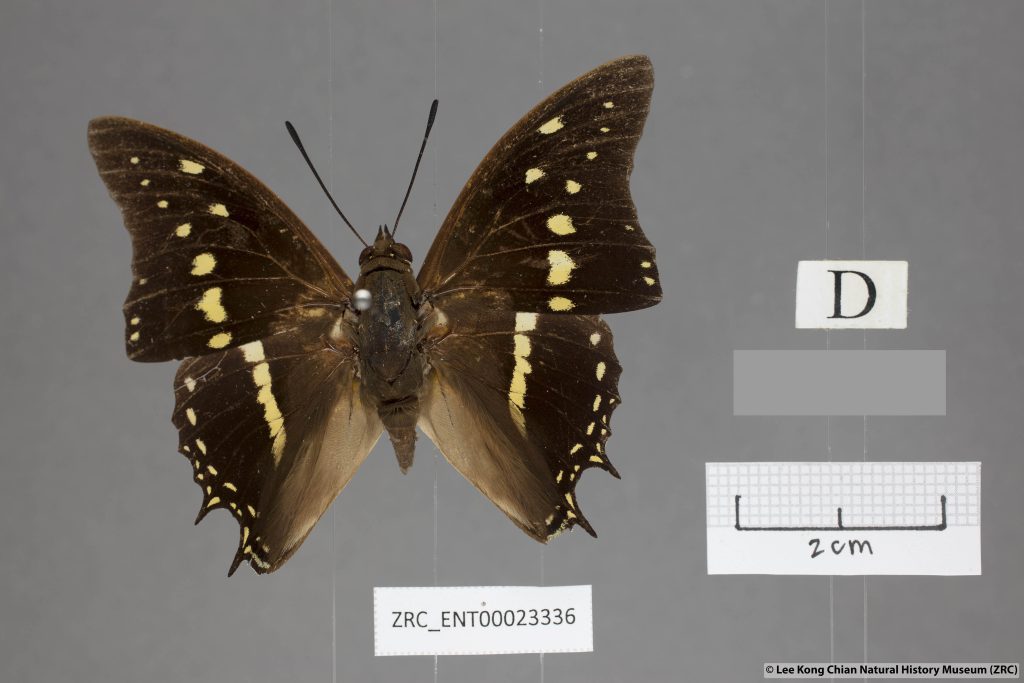
Charaxes solon echo is a very rare species found only in the Central Catchment Nature Reserve. Also known as the Black Rajah, it was first described by Arthur Gardiner Butler in 1867, based on specimens collected from Singapore. The males of this species are known to feed readily on carrion and overripe fruits, presumably for nutrients. [See the actual specimen used to describe the species here.]
Idea leuconoe chersonesia (Nymphalidae, Danainae)
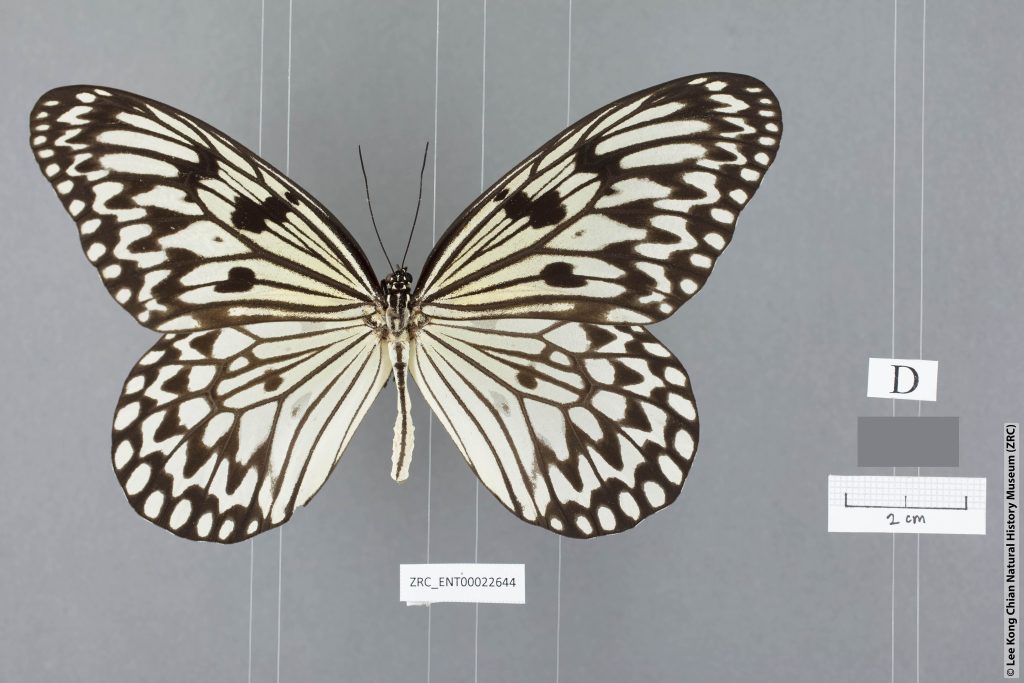
Idea leuconoe chersonesia is commonly known as the Mangrove Tree Nymph and a close relative to the Common Tree Nymph (Idea stolli logani). As its name implies, it is a mangrove specialist. Due to the loss of mangrove habitats, it is very rare and once thought to be locally extinct until a small population was found in Pulau Tekong in 2001.
Idea stolli logani (Nymphalidae, Danainae)
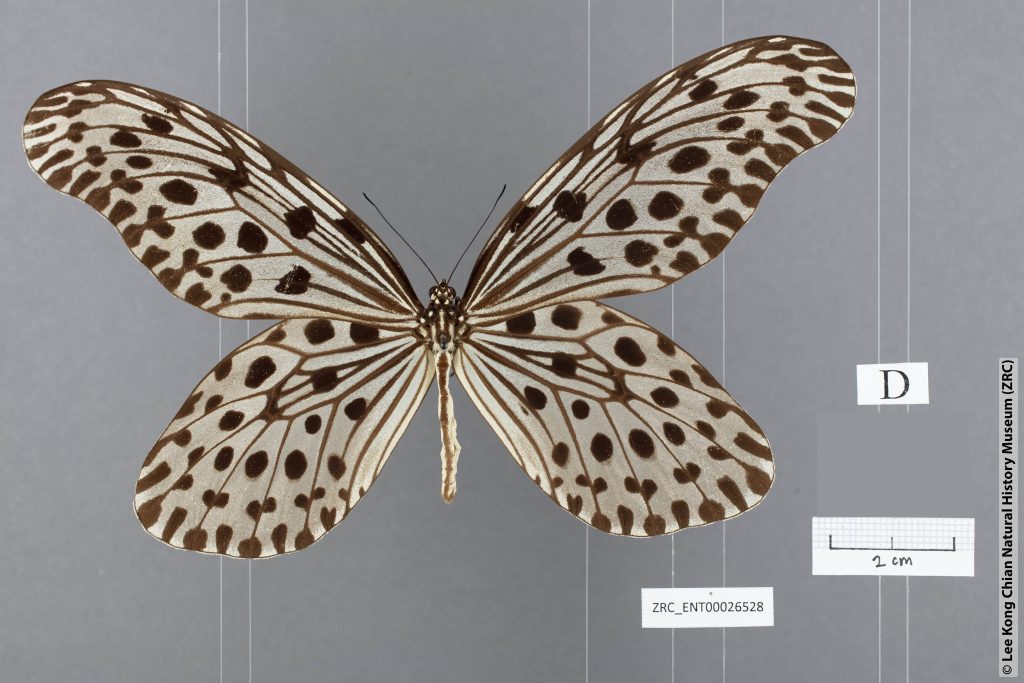
Idea stolli logani is a relatively large butterfly most often seen gliding along tree-tops in forested areas of Singapore. It has a distinctive flying behavior described as “elegantly floating in the air, flapping its wings in an unhurried manner”.
Tanaecia clathrata violaria (Nymphalidae, Limenitidinae)
Locally extinct
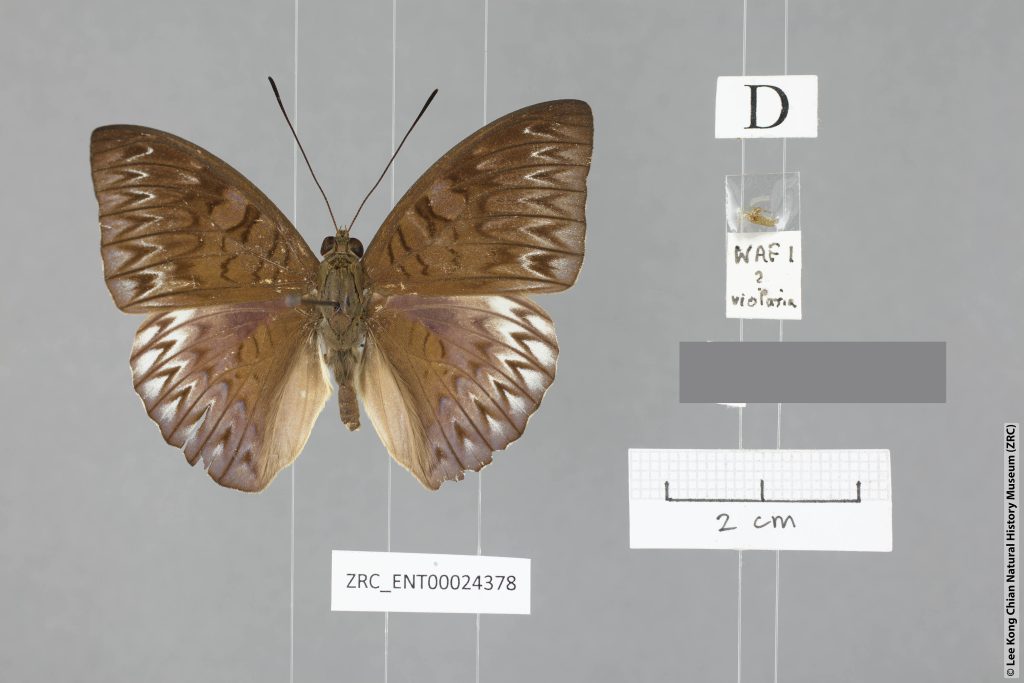
Tanaecia clathrata violaria is considered a locally extinct species. This subspecies is known to occur from southern Thailand to Singapore and also recorded from Aceh. The only known female was collected from Singapore but there has been doubt on the veracity of the locality since males were never found in Singapore.
Vindula dejone tiomana (Nymphalidae, Heliconiinae)
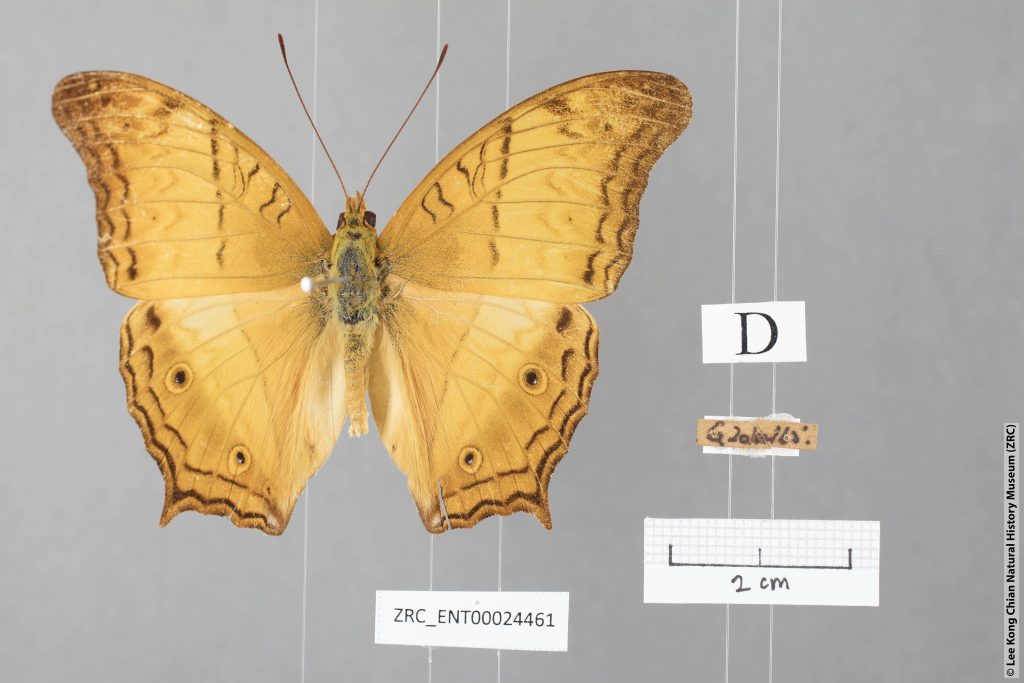
Vindula dejone tiomana occurs only on Tioman island, off the eastern coast of Peninsular Malaysia and nowhere else. It was first described by Henry Maurice Pendlebury in 1933, the last director of the Federated Malay States Museums before World War II, based on specimens collected in the early 1900s. Pendlebury suffered as a prisoner of war in Singapore during the war years and died a few weeks after liberation en route to England.
LYCAENIDAE
Anthene emolus goberus (Lycaenidae, Polyommatinae)
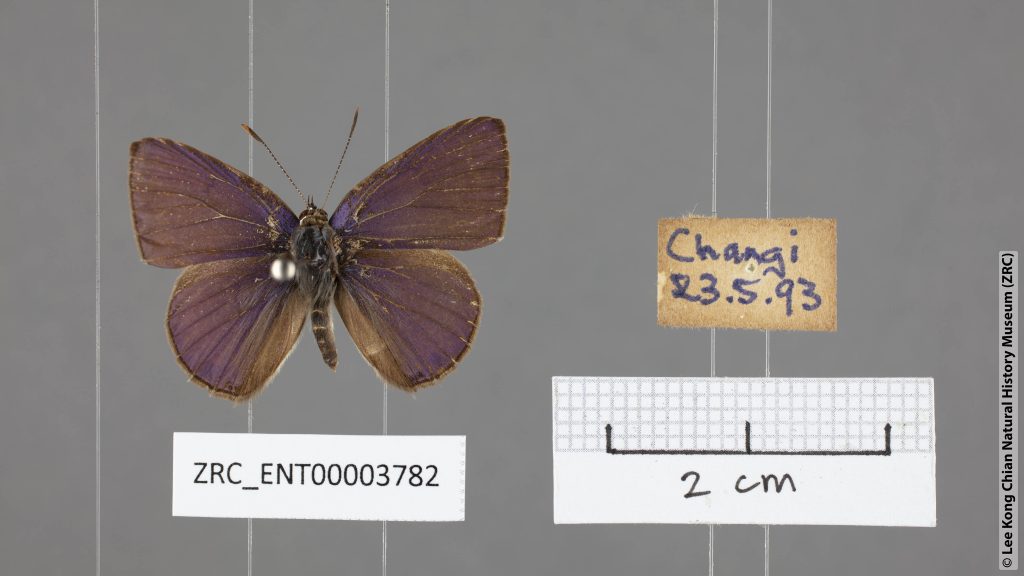
Anthene emolus goberus is commonly seen in urbanized parts of Singapore. It’s a tiny butterfly which feeds on a variety of host plants commonly found throughout Singapore; notably, Syzygium zeylanicum is especially common in parks and roadsides.
Arhopala kinabala (Lycaenidae, Theclinae)
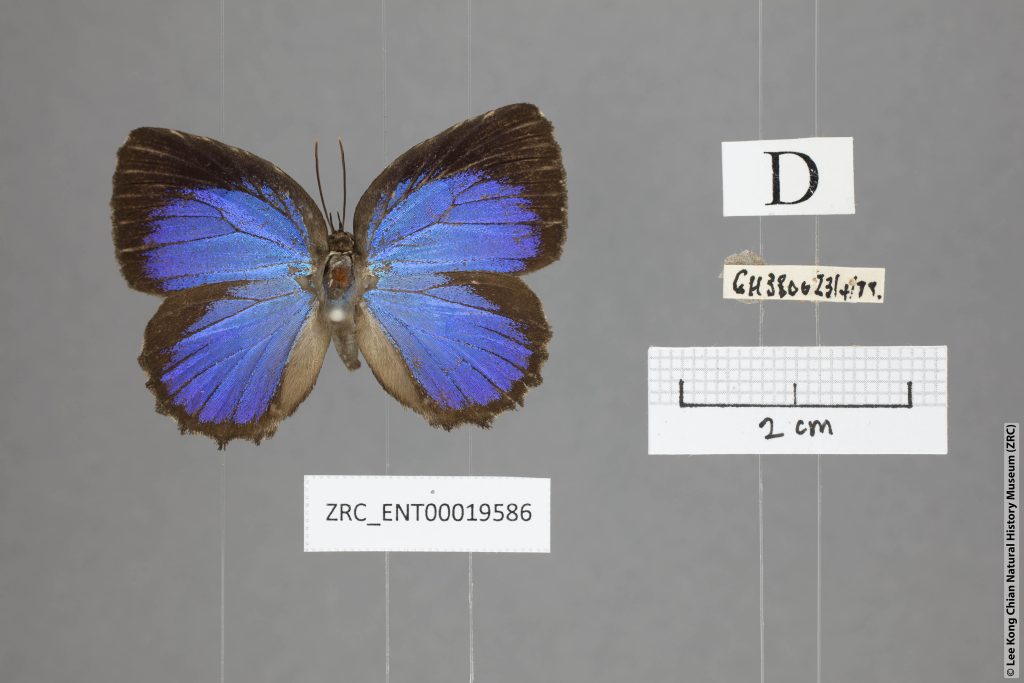
A highland specialist, Arhopala kinabala is considered to be a rare species. It was first described by Hamilton Herbert Druce in 1895, based on specimens found in Kinabalu Park, Sabah as a variant of Arhopala agesias. It is later known to occur also in Sumatra and Peninsular Malaysia.
Arhopala phanda phanda (Lycaenidae, Theclinae)
Locally extinct
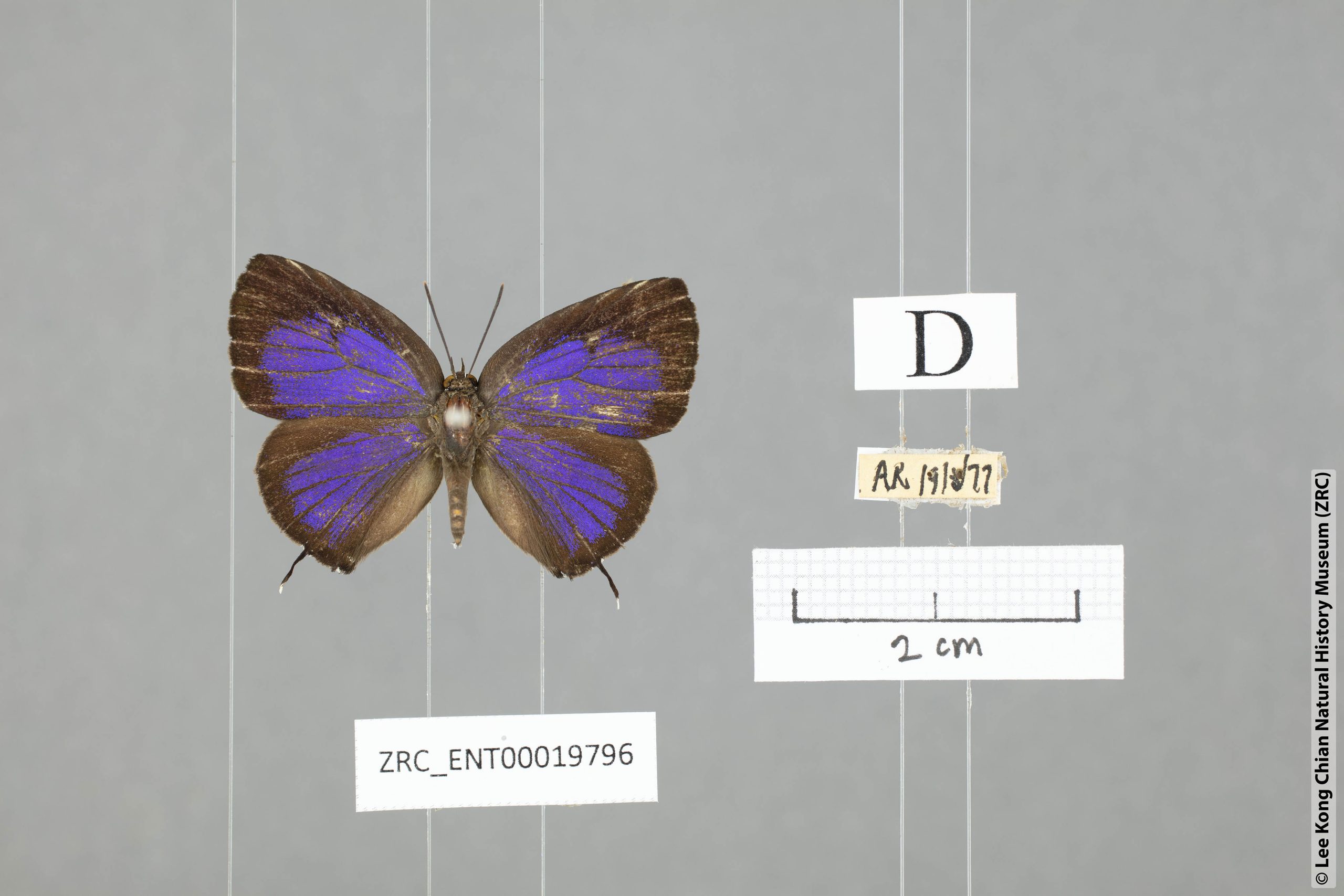
Arhopala phanda phanda is a locally extinct species of Lycaenidae. The female specimen used to describe this subspecies was collected from Singapore in 1938 by Lieutenant Colonel John Nevill Eliot, a butterfly expert specializing in Lycaenidae of the Oriental region. [See the actual specimen used to describe the species here.]
Arhopala trogon (Lycaenidae, Theclinae)
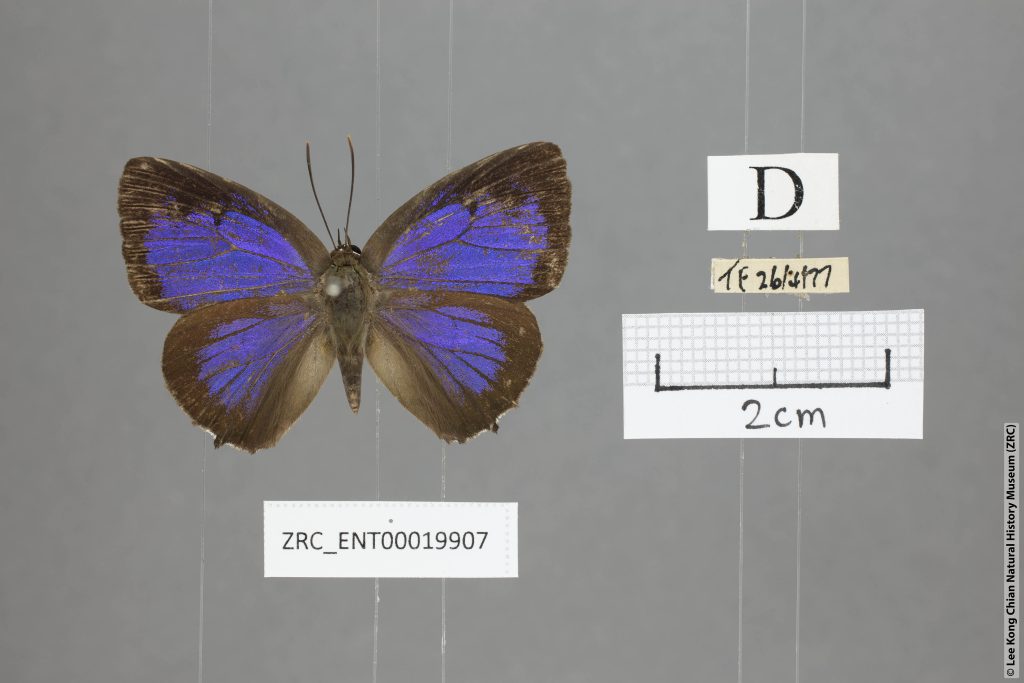
Arhopala trogon is a rare species in Singapore only known to occur within our nature reserves. This species has a limited local distribution range, highlighting the importance of nature reserves in preserving our natural heritage.
Caleta elna epeus (Lycaenidae, Polyommatinae)
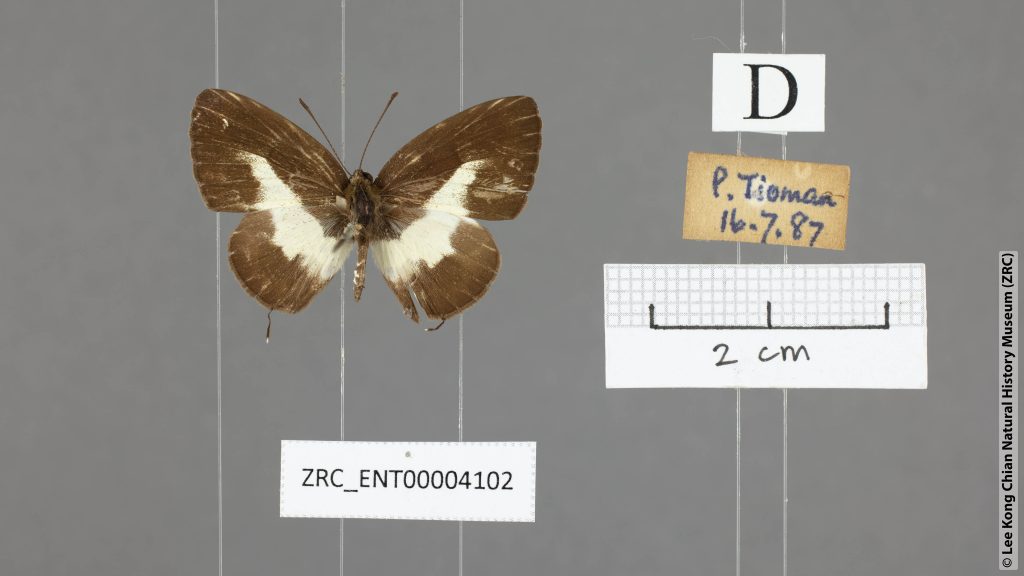
Caleta elna epeus is an endemic subspecies found only on Tioman island, Malaysia. Tioman island has more than 200 butterfly species recorded to date, with one species and 20 subspecies endemic to the island. Interestingly, even though Tioman island is only about 20km off the coast of Peninsular Malaysia, many of the butterfly subspecies have a closer resemblance to the Borneo subspecies than the Peninsular Malaysia subspecies.
Poritia philota philota (Lycaenidae, Poritiinae)
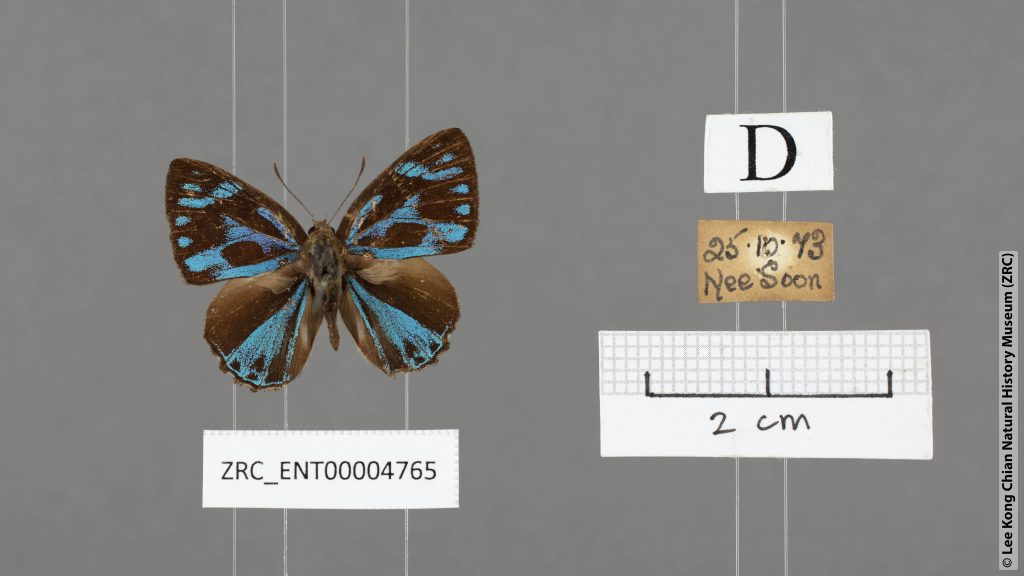
A small butterfly found along the Malayan Peninsula, but restricted to forested nature reserves within Singapore, Poritia philota philota is considered to be very rare locally. This individual was found in Nee Soon freshwater swamp within the Central Catchment Nature Reserve.
Pseudotajuria donatana (Lycaenidae, Theclinae)

Pseudotajuria donatana, once thought to be locally extinct, was rediscovered in the Central Catchment Nature Reserve in 2005. It has since been known to occupy primary forests as well as younger secondary forests. This species is very rarely sighted and is thought to prefer to forage on tree-tops.
Rapala cowani (Lycaenidae, Theclinae)
Locally extinct
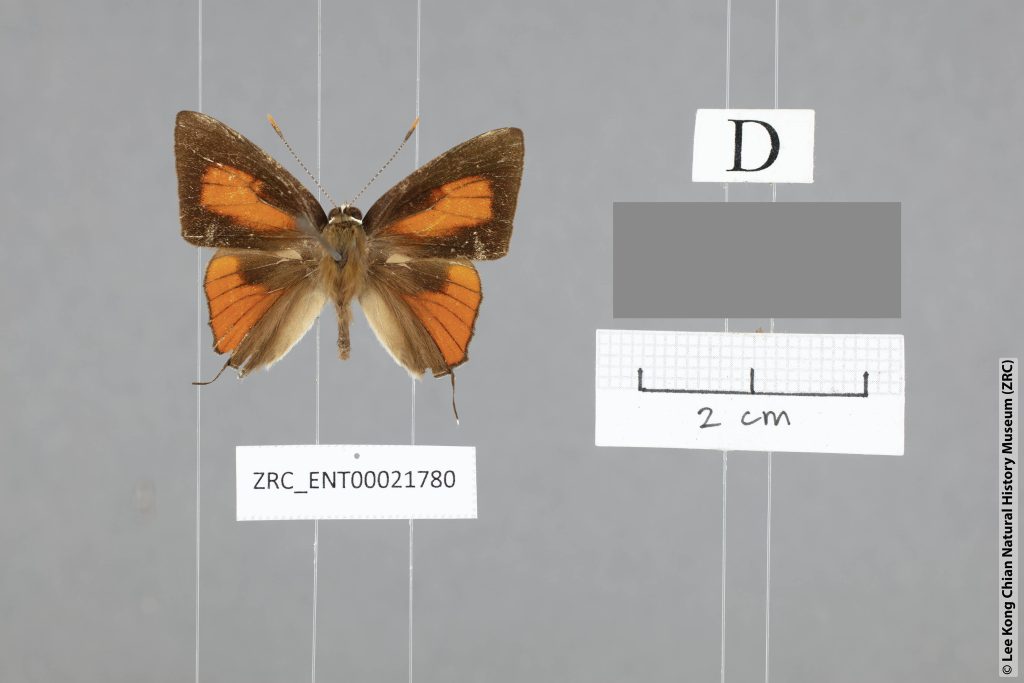
Rapala cowani is locally extinct. It was found near mangroves and coastal areas and likely affected by habitat loss. The specimen used to describe this species as new was collected from mangroves along Sungei Jurong in 1938 by Charles Francis Cowan and now resides in the London Natural History Museum.
PAPILIONIDAE
Lamproptera meges virescens (Papilionidae)
Locally extinct
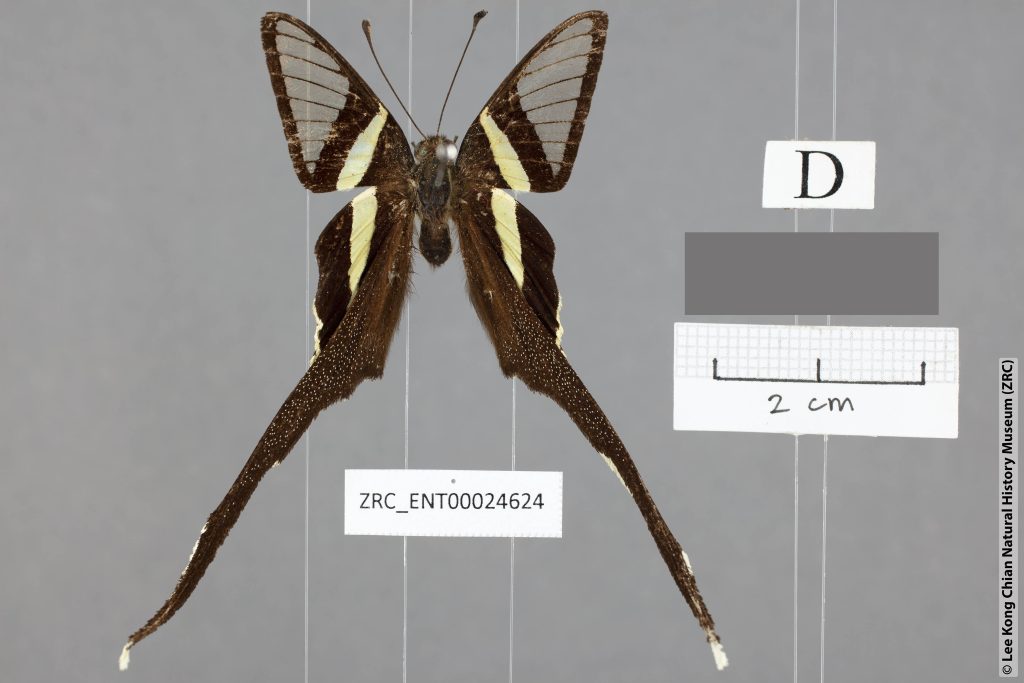
This butterfly is usually found near forested streams in sunlit spots with a unique behavior—the transparent wings with their long tails vibrate rapidly in flight and also at rest to produce a shimmering effect. It can be found at various elevations in Indochina and Peninsular Malaysia, but is locally extinct.
PIERIDAE
Eurema brigitta senna (Pieridae, Coliadinae)

While many other Grass Yellows (common name of Eurema butterflies) are relatively common in Singapore, Eurema brigitta senna is very rare and considered critically endangered in Singapore. This subspecies was re-discovered from a single population only in 2006 on mainland Singapore while it has also been sighted in Pulau Ubin. It feeds on an uncommon host plant Cassia mimosoides found in open grasslands which are often cleared land slated for further development in Singapore.
RIODINIDAE
Taxila haquinus haquinus (Riodinidae)
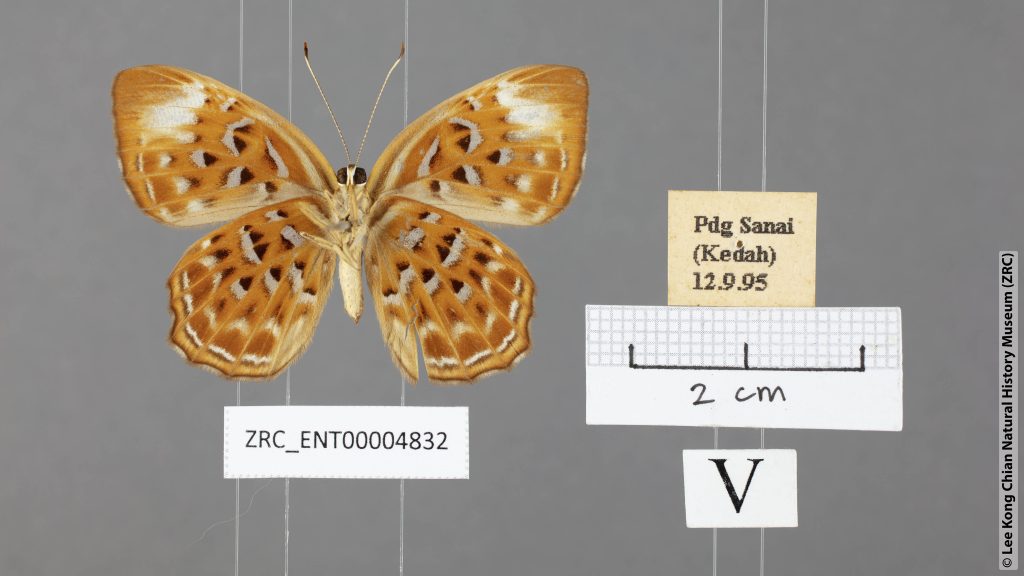
Taxila haquinus haquinus is an endangered butterfly species and a forest specialist. Its host plant is known to be Ardisia elliptica and is currently a targeted species for NParks’ Species Recovery Programme. [Dorsal view (top); Ventral view (bottom)]
To learn more about the digitalisation process of the project, click here.
This exhibition is in conjunction with the Singapore HeritageFest 2022. To view our full list of activities, click here.



